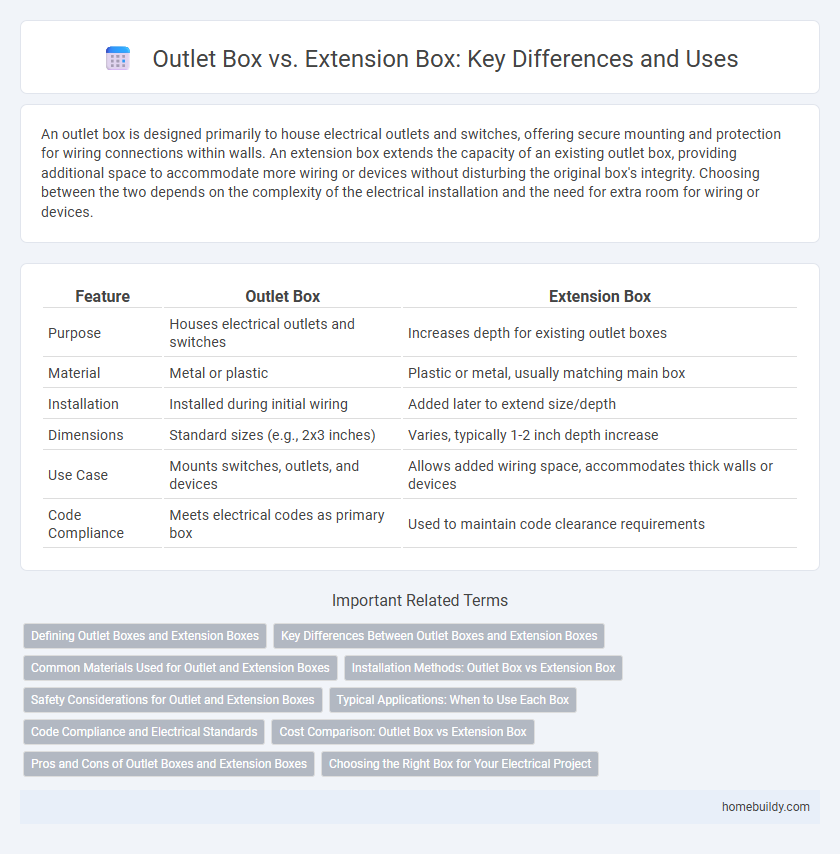An outlet box is designed primarily to house electrical outlets and switches, offering secure mounting and protection for wiring connections within walls. An extension box extends the capacity of an existing outlet box, providing additional space to accommodate more wiring or devices without disturbing the original box's integrity. Choosing between the two depends on the complexity of the electrical installation and the need for extra room for wiring or devices.
Table of Comparison
| Feature | Outlet Box | Extension Box |
|---|---|---|
| Purpose | Houses electrical outlets and switches | Increases depth for existing outlet boxes |
| Material | Metal or plastic | Plastic or metal, usually matching main box |
| Installation | Installed during initial wiring | Added later to extend size/depth |
| Dimensions | Standard sizes (e.g., 2x3 inches) | Varies, typically 1-2 inch depth increase |
| Use Case | Mounts switches, outlets, and devices | Allows added wiring space, accommodates thick walls or devices |
| Code Compliance | Meets electrical codes as primary box | Used to maintain code clearance requirements |
Defining Outlet Boxes and Extension Boxes
Outlet boxes are electrical enclosures designed to house switches, receptacles, or wiring devices at wall or ceiling points, providing secured mounting and protection. Extension boxes serve as add-ons to existing outlet boxes, increasing depth to accommodate additional wiring or devices without compromising safety or code compliance. Both types play crucial roles in ensuring proper electrical connections and organization within residential and commercial installations.
Key Differences Between Outlet Boxes and Extension Boxes
Outlet boxes are primarily designed to house electrical outlets or switches, providing a secure mounting point and protecting wiring connections within walls. Extension boxes serve as add-ons to existing outlet or junction boxes, increasing the box volume to accommodate additional wiring or devices without altering the wall structure. Key differences include their specific roles in electrical installations, size variations, and installation methods to ensure safety and code compliance.
Common Materials Used for Outlet and Extension Boxes
Outlet boxes and extension boxes are commonly made from materials such as plastic (PVC) and metal, including steel or aluminum, each offering distinct advantages in durability and electrical safety. Plastic outlet boxes provide corrosion resistance and ease of installation, while metal boxes are preferred for enhanced grounding and fire resistance in commercial or heavy-duty applications. Selection of material depends on factors like environmental exposure, electrical load, and local building codes to ensure compliance and longevity.
Installation Methods: Outlet Box vs Extension Box
Outlet boxes are typically installed flush with the wall surface, providing a secure mounting point for electrical devices and ensuring proper alignment with wall coverings. Extension boxes extend the depth of an existing outlet box, allowing additional space for wiring and devices when wall thickness increases or additional clearance is needed. Installation of extension boxes involves attaching them to the original outlet box and securing them firmly to maintain electrical safety and code compliance.
Safety Considerations for Outlet and Extension Boxes
Outlet boxes are designed to securely house electrical connections and support devices like switches and receptacles, minimizing fire hazards through proper insulation and grounding. Extension boxes provide extra space for wiring but must maintain secure connections and adequate cover to prevent exposure and electrical shocks. Ensuring that both outlet and extension boxes comply with local electrical codes and use compatible materials significantly enhances overall electrical safety.
Typical Applications: When to Use Each Box
Outlet boxes are typically used for installing electrical outlets and switches in walls or ceilings, providing secure mounting and protection for wiring connections. Extension boxes are designed to increase the depth of existing outlet boxes, allowing for additional wiring space when installing bulky devices or multiple wires. Choose outlet boxes for standard receptacles and switches, while extension boxes are ideal for renovations or upgrades requiring extra room without replacing the original box.
Code Compliance and Electrical Standards
Outlet boxes and extension boxes differ in application but must both meet National Electrical Code (NEC) requirements to ensure electrical safety and code compliance. Outlet boxes are designed to house electrical devices like switches and receptacles and must be securely mounted with proper wiring methods, while extension boxes provide additional space for wire connections within an existing box volume limit. Both types must comply with NEC section 314 for box fill calculations, grounding, and accessibility to maintain proper electrical standards.
Cost Comparison: Outlet Box vs Extension Box
Outlet boxes generally cost less than extension boxes due to their simpler design and smaller size, with prices ranging from $1 to $5 per unit. Extension boxes, which provide extra wiring space and accommodate larger or multiple devices, typically range from $3 to $10 depending on material and dimensions. Budgeting should consider the specific electrical needs and installation complexity to determine the most cost-effective choice between outlet and extension boxes.
Pros and Cons of Outlet Boxes and Extension Boxes
Outlet boxes provide secure mounting points for switches and receptacles, ensuring safe electrical connections and easy access for maintenance, but their fixed depth may limit wiring space. Extension boxes offer increased wiring capacity and flexibility by adding depth, suitable for complex installations, yet they can increase overall wall space and may complicate device mounting. Choosing between outlet and extension boxes depends on the required wiring volume, installation space, and electrical code compliance for safety standards.
Choosing the Right Box for Your Electrical Project
Outlet boxes are designed primarily for housing electrical outlets and switches, providing secure mounting and protection for wiring connections in walls. Extension boxes extend the existing outlets or switches, offering additional space for wiring or devices without altering the original box location. Selecting the right box depends on wiring complexity, device count, and available wall space, ensuring safety and compliance with electrical codes.
Outlet box vs Extension box Infographic

 homebuildy.com
homebuildy.com